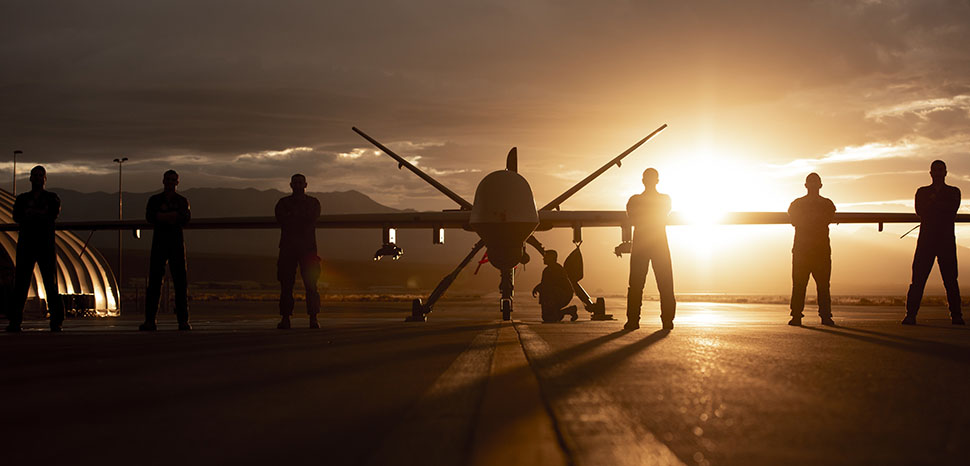Usman Haider

India recently signed an agreement with the U.S. to purchase 31 Mq-9B Sea-Guardian high-altitude unmanned aerial vehicles (UAV) worth $3.07 billion. The deal will profoundly boost the Indian Navy’s airborne anti-submarine warfare (ASW) capabilities. Of the total 31, the Indian Navy will get 15 UAVs. Once India inducts the Mq-9b shortly, the Indian Navy will become the second in the world, after the US Navy, to operate an airborne anti-submarine triad. Moreover, the acquisition will allow it to search and destroy Pakistan’s conventional attack submarines with greater precision than before.
The Mq-9b is a cutting-edge UAV manufactured by General Atomics, designed to execute various tasks. However, what makes it unique is its capability to hunt and kill enemy submarines effectively . It is the only fixed-wing UAV in the world with the capacity to carry sonobuoys. The capacity to carry sonobuoys as its payload makes Mq-9b a formidable weapon. It is a marine device deployed by maritime planes and helicopters in anti-submarine operations. It has four wing stations that can hold 4 SDS pods, permitting it to carry either 40 ‘A’ size or 80 ‘G’ size sonobuoys.
Mq-9b can analyze data from around 32 sonobuoys, to detect, classify and track underwater systems. The platform demonstrated this capability in a recent exercise conducted by the US Navy known as Integrated Battle Problem in 2021. It provides naval commanders with a low-cost, stand-alone capability, as well as a potent replacement to manned maritime patrol aircraft.
Additionally, Mq-9b has a long endurance capability of around 30+ hours that exceeds the limits of manned maritime aircraft and helicopters by a large margin. Its ability to remain on station for extended time makes it a perfect candidate to find and sink enemy submarines in open oceans, which is a time-consuming process. It also costs $5,000 per hour compared to P-8 costing $35,000 per hour, thus making it a cost-effective platform. Moreover, it has an operational range of over 5000 nautical miles and a flight ceiling of over 40,000 feet. It also has an inbuilt tactical data link system allowing it to communicate with other platforms in real-time.
The formal induction into the Indian Navy’s fleet will make the service the first one besides the U.S. to have an active airborne anti-submarine triad. It is comprised of maritime patrol aircraft, dual-purpose helicopters, and long-endurance unmanned aerial vehicles and includes P-8 Poseidon long-range maritime patrol aircraft, Mq-9b Sea-Guardian, and MH-60R with ASW capabilities. P-8 and Mh-60 retain the same capability as the Mq-9b to find and track enemy submarines. A P-8 on an ASW mission can carry a payload of 129 A-type sonobuoys or a mixture of sonobuoys and torpedoes, and 12 aircraft are in service with India’s naval arm. Similarly, the MH-60 can carry both payloads simultaneously, but the number would be lower than the P-8. The Indian Navy presently operates with six MH-60R ASW out of 24 ordered in a deal worth USD 2.6 billion in 2020. All 24 are likely to become operational in the next two years.
The Mq-9b will undeniably augment the search-and-tracking capabilities of the Indian Navy, allowing it to accurately ascertain the whereabouts and sink Pakistan’s submarines, thereby placing the Pakistan Navy in a disadvantaged position. This will happen because of the interoperability with the existing anti-sub platforms (P-8 and Mh-60) operational with the Indian Navy and its capability to take charge of the mission in the absence of P-8 and Mh-60.
On the interoperability side, Mq-9b’s will assist the Indian Navy’s P-8 and MH-60 sub-killers by providing them an extended coverage of the targeted area. This is possible because the data link system in Mq-9b allows it to communicate and pass on information on Pakistani subs with P-8 and MH-60 platforms in real-time. This will make Mq-9b the spearhead of the airborne triad, conducting missions beyond territorial boundaries and detecting Pakistan’s subs on the high seas.
Additionally, the multi-domain mission capability to not only control the mission but also take charge of other platforms makes it a formidable system. At present, the P-8 and Mh-60 have limited mission time before they have to go back for refueling. Moreover, even if aerial refueling is being conducted, human fatigue remains an issue. On the contrary, the Mq-9b is unmanned and can stay airborne surveilling the targeted area for subs for over a day and a half.
The Mq-9b will be a game-changer once inducted and will likely challenge the Pakistan’s Navy offensive operations significantly. Its ability to survey the area for a longer duration and its interoperability are what make it a deadly platform. India will not be restricted to just 15 platforms, but will purchase additional pieces as well. The Pakistan Navy will have testing times ahead and to neutralize the threat; it has to strengthen its naval air arm by inducting modern air superiority aircraft. Additionally, the operational principle for detecting enemy subs by sonobuoys is acoustic, and there is an urgent need to reduce the acoustic signature of Pakistan’s platforms, especially the eight new Yuan class subs coming from China.
No comments:
Post a Comment